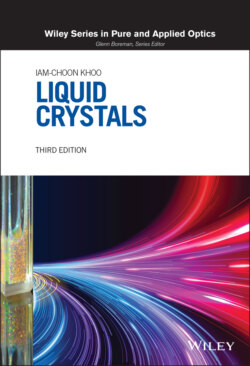Читать книгу Liquid Crystals - Iam-Choon Khoo - Страница 51
3.5.1. Hydrodynamics of Ordinary Isotropic Fluids
ОглавлениеConsider an elementary volume dV = dx dy dz of a fluid moving in space as shown in Figure 3.9. The following parameters are needed to describe its dynamics:
position vector: ,
velocity: ,
density: ,
pressure: , and
forces in general: .
In later chapters where we study laser‐induced acoustic (sound, density) waves in liquid crystals, or generally, when one deals with acoustic waves, it is necessary to assume that the density is a spatially and temporally varying function. In this chapter, however, we “decouple” such density wave excitation from all the processes under consideration and basically limit our attention to the flow and orientational effects of an incompressible fluid. In that case, we have
Figure 3.9. An elementary volume of fluid moving at velocity v (r, t) in space.
(3.50)
For all liquids, in fact for all gas particles or charges in motion, the equation of continuity also holds
This equation states that the total variation of over the surface of an enclosing volume is equal to the rate of decrease of the density. Since ∂ρ/∂t = 0, we thus have, from Eq. (3.51),
(3.52)
The equation of motion describing the acceleration of the fluid elements is simply Newton’s law:
Studies of the hydrodynamics of liquids may be centered around this equation of motion, as we identify all the various origins and mechanisms of forces acting on the fluid elements and attempt to solve their motion in time and space.
We shall start with the left‐hand side of Eq. (3.53a). Since ,
(3.53b)
The force on the right‐hand side of Eq. (3.53a) comes from a variety of sources, including the pressure gradient −Δρ, viscous force , and external fields (electric, magnetic, optical, gravitational, etc.). Equation (3.53a) thus becomes
Figure 3.10. Stresses acting on opposite planes of an elementary volume of fluid.
Let us ignore the external field for the moment. The formulation of the equation of motion for a fluid element is complete once we identify the viscous forces. Note that, in analogy to the pressure gradient term, the viscous force is the space derivation of a quantity that has the unit of pressure (i.e. force per unit area). Such a quantity is termed the stress tensor σ (i.e. the force is caused by the gradient in the stress; see Figure 3.10). For example, the α component of may be expressed as
(3.55)
Accordingly, we may rewrite Eq. (3.54) as
where summation over repeated indices is implicit.
By consideration of the fact that there is no force acting when the fluid velocity is a constant, the stress tensor is taken to be linear in the gradients of the velocity (see Figure 3.10), that is,
The proportionality constant η in Eq. (3.57) is the viscosity coefficient (in units of g cm−1 S−1). Note that for fluid under uniform rotation (i.e. ), we have ∂vβ/∂xα = −∂vα/∂xβ, which means σαβ = 0.
Equation (3.56), together with Eq. (3.57), forms the basis for studying the hydrodynamics of an isotropic fluid. Note that since the viscosity for is a spatial derivative of the stress tensor, which in turn is a spatial derivative of the velocity, is of the form . Equation (3.54), therefore, may be written as
(3.58)
which is usually referred to as the Navier–Stokes equation for an incompressible fluid.
